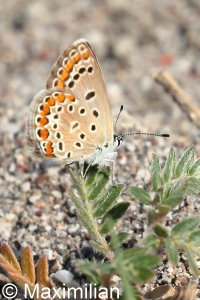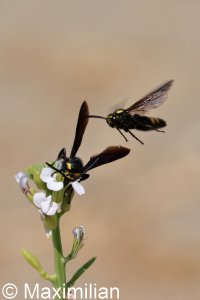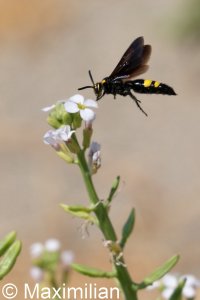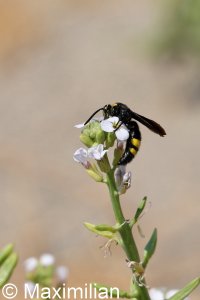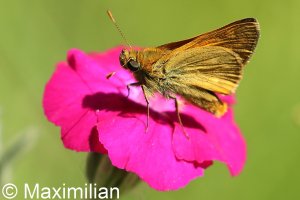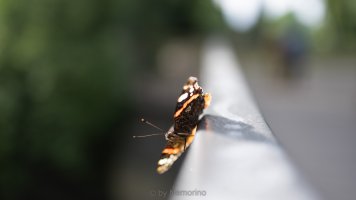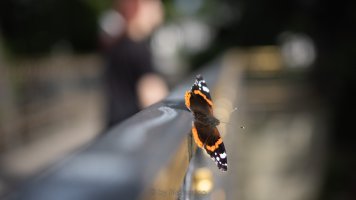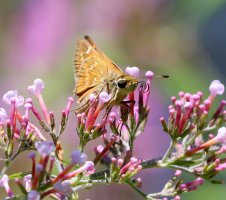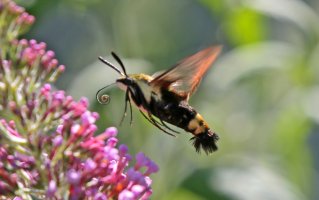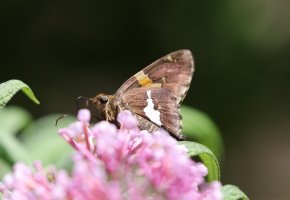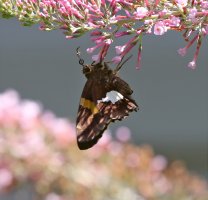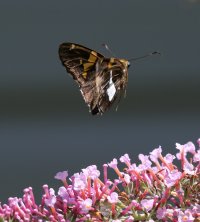You are using an out of date browser. It may not display this or other websites correctly.
You should upgrade or use an alternative browser.
You should upgrade or use an alternative browser.
Butterflies, Moths and Assorted Insects...
- Thread starter dpc
- Start date
- Oct 29, 2016
- 650
- 1,205
- 6,034
Nice shot with intense color contrast (obviously)! What type of butterfly is that?
Upvote
0
When on Rhodes and chasing for black pennant dragonflies, I came across an insect that was black and yellow and always flying.
It was flying in a dragonfly style and so fast that I couldn't recognize its shape and form.
So I went trying to shoot it in flight. And in the end I could get one on the ground.
So now I know those are scolia hirta, in German "Borstige Dolchwespe" (translated: "bristly dagger wasp" )
)
These were the best in flight:
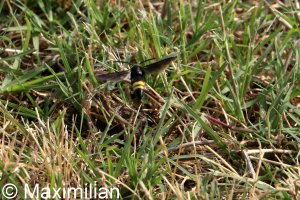
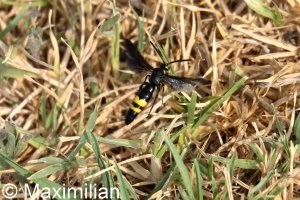
This is the first on the ground:
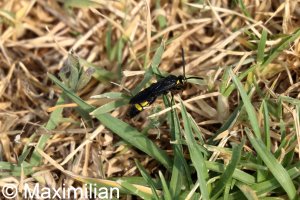
More to come...
It was flying in a dragonfly style and so fast that I couldn't recognize its shape and form.
So I went trying to shoot it in flight. And in the end I could get one on the ground.
So now I know those are scolia hirta, in German "Borstige Dolchwespe" (translated: "bristly dagger wasp"
These were the best in flight:


This is the first on the ground:

More to come...
Upvote
0
Could it be Thymelicus sylvestris?Still don't know 100% what this is, but I suppose it's from the family hesperiidae.
If someone knows, please let me know.
View attachment 204490
Like in this post
Upvote
0
Maybe. Thanks, Oskar. But I always get confused with these little brown fellows.
Upvote
0
Great shot!EDIT: Hummingbird Clearwing?
Should be a hemaris fuciformis, broad-bordered bee hawk-moth.
Upvote
0
Look for Hemaris and depends where you took the photo you may have an easy ID...
Upvote
0
josephandrews222
I Shot the Sheriff, but I Did Not Shoot the Deputy
Thank you.Look for Hemaris and depends where you took the photo you may have an easy ID...
Hemaris thysbe (I think).
A few better(?) images from the same set: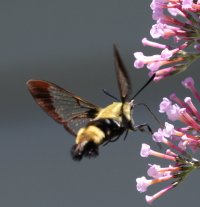

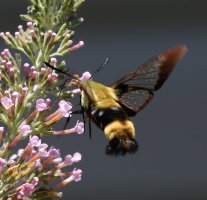
I've been one of the bigger 'honks' on this website for Canon's M bodies...and have, for a decade or so now, given serious thought to the subject of acquiring images with the aid of a viewfinder vs using an LCD screen. For all I know this has been discussed in detail already here...
I can distinctly recall an 'early' epiphany (for me) about a decade ago when I learned that 'taking pictures' at a rock concert, seated/standing two rows from the stage (widely varying lighting conditions)...was facilitated quite nicely without the aid of a viewfinder (using the tiny-and-stealthy Canon S95)...adjusting exposure compensation on-the-fly...constantly...for the better part of an hour (hundreds of images)...with constant monitoring of the rear-screen LCD. Viewing the LCD allowed examination of the entire image and stage...and the lighting conditions for much of the stage. It is almost as if half-an-arms-length distance between my eyes and the screen I was examining enabled me to be more aware of what was happening on-stage, including lighting changes. For printed images up to 8x10...it really worked...and I've never forgotten that.
But the images presented here (5DMkIII + 100-400II) were acquired using the optical viewfinder...and if I had been using my M6MkII instead of the full-frame 5D, I would have attached the electronic viewfinder--telephoto lens usage at the long end, at least in my hands, REQUIRES a viewfinder.
In this case, all I wanted to see was the 'target'...probably obvious to many reading this but not so much to me.
Upvote
0
Looks like H. thysbe for me too... On other hand I have not much info about the rest of Hemaris in N. America (3 more I think?).Thank you.
Hemaris thysbe (I think).
A few better(?) images from the same set:
View attachment 204607View attachment 204608View attachment 204605
I've been one of the bigger 'honks' on this website for Canon's M bodies...and have, for a decade or so now, given serious thought to the subject of acquiring images with the aid of a viewfinder vs using an LCD screen. For all I know this has been discussed in detail already here...
I can distinctly recall an 'early' epiphany (for me) about a decade ago when I learned that 'taking pictures' at a rock concert, seated/standing two rows from the stage (widely varying lighting conditions)...was facilitated quite nicely without the aid of a viewfinder (using the tiny-and-stealthy Canon S95)...adjusting exposure compensation on-the-fly...constantly...for the better part of an hour (hundreds of images)...with constant monitoring of the rear-screen LCD. Viewing the LCD allowed examination of the entire image and stage...and the lighting conditions for much of the stage. It is almost as if half-an-arms-length distance between my eyes and the screen I was examining enabled me to be more aware of what was happening on-stage, including lighting changes. For printed images up to 8x10...it really worked...and I've never forgotten that.
But the images presented here (5DMkIII + 100-400II) were acquired using the optical viewfinder...and if I had been using my M6MkII instead of the full-frame 5D, I would have attached the electronic viewfinder--telephoto lens usage at the long end, at least in my hands, REQUIRES a viewfinder.
In this case, all I wanted to see was the 'target'...probably obvious to many reading this but not so much to me.
Upvote
0
josephandrews222
I Shot the Sheriff, but I Did Not Shoot the Deputy
Thanks for your helpful response. If it weren't for Google etc I would be truly clueless on this subject.Looks like H. thysbe for me too... On other hand I have not much info about the rest of Hemaris in N. America (3 more I think?).
Quoting from here:
"There are four species of hummingbird moths in North America. The most familiar ones are the Snowberry Clearwing (Hemaris diffinis) and the Hummingbird Clearwing (Hemaris thysbe)."
I so enjoy reading these links because some of what I read is so, so correct...and some of what I read ties into other nonsense I've posted on CR.
Specifically (from the link):
"Perhaps one of the most delightful insect visitors to your garden is the hummingbird moth. Several species of the genus Hemaris deserve this name and for very good reason. They fly and move just like hummingbirds. Like them, they can remain suspended in the air in front of a flower while they unfurl their long tongues and insert them in flowers to sip their nectar. They even emit an audible hum like hummingbirds. Quite often inexperienced garden visitors notice what they think is a tiny hummingbird fleeting among flowers such as bee balm (Monarda). They listen incredulously when one explains to them that what they just saw was not a bird but a moth."
I am the 'inexperienced garden visitor' (visiting my neighbor's butterfly bush), and this is exactly what happened...in that when I was collecting the images with a 5DMkIII and its viewfinder, I thought I was looking at a hummingbird (!), so much so that when I moved the files to my computer I thought I'd missed them in the copy process (because I saw no hummingbirds when reviewing the images!).
Looking through a viewfinder really is different from the LCD screen...something already obvious to many reading this.
The first hummingbird moth images I posted in this thread were not very good (too slow shutter speed).
The following images I'm a bit proud of...in that I 'worked' a bit to get them...and the first of these (f7.1 and 1/8000s exposure time; ISO 1600) may in fact demonstrate the limitations of the 5DMkIII/100-400 II @ 400 combo (at least in my hands).
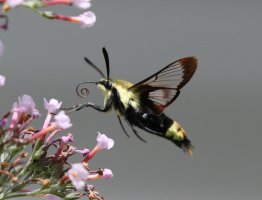
Details for the following image (same body/camera; ISO 3200; f16; 1/4000s exposure time):
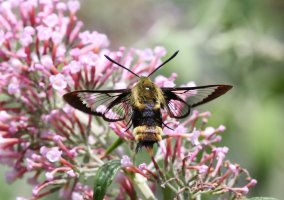
I think the photo data are available via download. Thanks for reading.
Upvote
0
Similar threads
- Replies
- 30
- Views
- 1K
- Replies
- 2
- Views
- 5K

